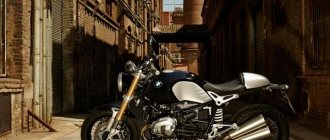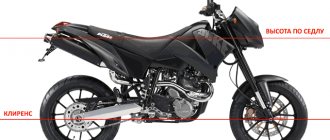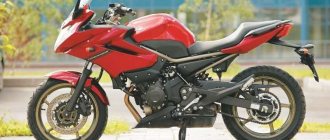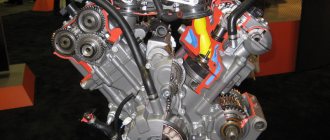Hyosung GT650R:
2014, 647 cm3, 74 l.
pp., 215 kg, 399,000 rub. (2017) text: Alexander Barkalov photo: Nikita Kolobanov
in the photo: Alexander Barkalov
»The GT650R model from the Korean manufacturer Hyosung fits quite well into the concept of an inexpensive, reliable and attractive motorcycle for every day. Despite the presence of serious shortcomings, the device has enjoyed good success among consumers for many years. In 2013, the GT650R underwent another restyling... but only test tests will show whether the new motorcycle is better.
Hyosung Motorsand Machinery was founded in Korea in 1978. A year later, the plant signed an agreement on cooperation and collaboration with the Japanese company Suzuki Motors. Since then, the Koreans have been closely involved in the production and sale of motorcycles under their own brand, successfully combining copied Suzuki components and components of their own design in their design.
The history of the GT650 model goes back to 2004, when Hyosung specialists developed their 650 cc V-Twin based on the Suzuki SV650 engine. It was around this engine, renowned for its reliability and decent performance, that the first generation GT650R Comet was built. Since then, the Hyosung road sport bike family has undergone a few minor facelift surgeries, but overall the GT650 remains as close to the original as possible.
Despite the company’s eloquent press releases dedicated to the release of the updated version of the GT650R and presenting it as nothing less than a new model, there are not many changes in the design of the motorcycle, and they are mostly purely cosmetic. The main innovation is the redesigned front fairing.
During the facelift of the front part, the shape of the air intakes was changed, which are now barely noticeable. In addition, the headlight acquired a diamond-shaped outline, which not only benefited the appearance of the motorcycle, but also gave it a little Italian touch in the spirit of the MV Agusta F4 or Bimota Tesi.
The Koreans also slightly refreshed the dashboard by adding a block of indicator lamps and changing the color of the backlight. At first glance, the innovations are minimal, but not a trace of the former archaism remains - the dashboard has become much more pleasant to use. Actually, this is where the list of innovations found in the Hyosung GT650R 2013 model year can be considered complete.
To be and to seem
The updated lines not only refreshed the silhouette of the Korean motorcycle, but also made its appearance even more similar to its sports counterparts from Japanese and European manufacturers. To be fair, it’s worth saying that the Hyosung GT650R has only a little more “sportbike” flavor than a grocery cart from the nearest supermarket.
Of course, developed plastic fairings, clip-ons installed under the upper crossmember, and an impressively sized muffler carefully create the image of an uncompromising thunderstorm on race tracks and night streets. But this is the case when appearances are deceiving. Once behind the wheel of a GT650R, you don’t immediately realize that this is an ordinary “road bike”, hiding under the guise of a sportbike.
It seems that the steering wheel is not set too high, and the footrests, which have several height adjustments, also force you to bend your legs decently at the knee joint, deeply “packing” your limbs into the stampings on the tank... And only a desperate masochist would call the harsh seat a sybarite’s dream! It would seem that all the signs of a real sportbike are present, but the thought that they are persistently trying to mislead you cannot get out of your head. And the very first meters in motion put everything in its place.
The upper traverse, without a single hole, looks monumental and must weigh an indecent amount. However, superhero figures as a key fob on the ignition key neutralize any shortcomings of the motorcycle. The instrument panel is simple and concise: a dial tachometer, a digital speedometer and two “columns” informing about the fuel level and engine coolant temperature.
As soon as the motorcycle starts moving, all the pseudo-sportbike attributes fade in the shadow of the V-shaped “deuce” from the late 90s of the last century. The characteristics of the V-twin engine installed in the steel frame of the GT650R are so average and universal that Hyosung even installs it on the GV650 Aquila cruiser!
A licensed copy of the Suzuki SV650 engine produces 74 hp. s., which by modern standards, frankly speaking, is a rather modest value. The engine characteristics look especially detrimental when compared with the performance of modern 600 cc sportbikes, the power of which does not fall below 100 hp. With.
However, if you mentally come to terms with the fact that underneath you is not a sports vehicle, but only a “packed” road bike, then the capabilities of the 2-cylinder engine no longer look so depressing.
The torque produced by the engine is quite enough to quickly accelerate at any time, without switching to a lower gearbox level. The V-twin pulls confidently from just 3,500 rpm right up to the limiter, delivering smooth but punchy acceleration.
The well-worn 647 cc “two” also has its own characteristics: as soon as the tachometer needle crosses the 6000 rpm mark, the engine begins to vibrate furiously, transmitting a tremor to the steering wheel and footpegs. At first you don’t pay attention to this feature, but after 30 minutes of vibromassage procedures there is a strong desire to stop and take a breath.
For testing, I received a Hyosung GT650R with a clearly “sick” engine: at about 5000 rpm, the tachometer needle froze for a split second, and the power unit interrupted the transmission of traction to the rear wheel. A seemingly trivial flaw in the slow corners of the karting track threatened to end in an inevitable fall, which made driving the GT650R even more exciting. However, there is no doubt that this “bug” is typical for this particular motorcycle, since no similar problems were found on the ST7 and GT650P models.
With a high degree of probability, even installing brake pads from a well-known manufacturer will not be able to solve the problem of ineffective brake operation - the problem is in the mechanisms themselves... However, reinforced hoses and new pads should at least slightly improve the braking system. Already in the basic configuration, the motorcycle is equipped with adjustable footrests - just like on real sportbikes! Not the most useful accessory for a road warrior, but still nice.
The tough operation of the gearbox deserves much more attention from the future owner of the GT650R: a noticeable force must be applied to the gearshift foot, and each shift, especially from the first to the second stage of the transmission, is accompanied by a characteristic sound. At first, finding a neutral gear will also require some skill, but as you get used to the features of the gearbox, this problem will solve itself.
Hyosung GV650 Progress. Challenger
A person gets used to everything: several years have passed since the appearance of Korean Hyosung motorcycles on the Russian market, and their name has not only become euphonious, but no longer causes snickers and giggles. This was also influenced by the active improvement of technology.
Natalya Umnova
Hyosung GV650 Progress. Price: from 439,000 rub. On sale: since 2013
I started getting acquainted with Hyosung products with the mid-sized cruiser GV650 Progress - motorcycles of this class are simple in design, reliable, and you usually don’t expect outstanding technical characteristics from them. But at the same time they must be beautiful or at least unusual in appearance.
The display could be bigger and stronger
Progress meets these criteria completely. Korean designers managed to reproduce the best features of the style leaders - Harley-Davidson V-Rod and Yamaha Warrior - and supplement them with their own elements. The result is a very interesting and eye-catching appearance, decorated with a sufficient amount of chrome and plastic painted to look like chrome - where would we be without it.
The design is traditional for the class: V-twin engine, front inverted telescopic fork, rear pendulum suspension with two shock absorbers and, interestingly, a progressive belt drive, like the “big ones”.
LED tail light looks great
The first “feature” lies in wait where you didn’t expect it: having tried more than one motorcycle, I still didn’t immediately find the ignition switch, located on the right closer to the steering wheel, under the protrusion of the fairing... Original, but completely inconvenient and impractical: even a soft key fob hanging from the key through The plastic will wear out for a while.
The second point, not typical for the class, is the digital tidy. It doesn’t show enough data; the gear engaged indicator is sorely missing, which, in my opinion, must be present on any modern electronic display, even a budget one. In addition, the monitor is not very durable: while washing, the pressure of water accidentally “killed” the pixels in the corner. And in general, the quality of some parts and the assembly as a whole leaves much to be desired: upon careful inspection, sloppy joints and protruding wires are visible. While driving, the instrument panel and something inside it, as well as some other elements in the front part of the motorcycle, loudly rumble and squeak. The fuel pump squeals, spoiling the driver’s impression of the noble muttering of the exhaust... But, as they say, “crickets” do not affect the speed, and I’ll tell you what does affect it now.
The rear brake foot is installed in a strange way: it is difficult to “hit” it with your foot
Unlike many of its classmates, the Hyosung GV650 Progress engine produces a very respectable 73 hp. With. and 61.4 Nm of torque - some larger engines have figures that are one and a half times lower! In addition, the Progress power unit is flexible and high-torque - the motorcycle starts unexpectedly quickly and quickly accelerates to 120 km/h. Driving faster on this vehicle is no longer comfortable due to insufficient wind protection and the design features of the fairings, which direct air flows to the driver’s legs with such force that they are literally blown off the footrests. You have to either lean into the passenger seat, which is inconvenient for a driver shorter than 170 cm, or strain your legs, which quickly get tired because of this. In addition to this, the motorcycle vibrates strongly, trembles, and throughout the entire speed range - the tremor is most noticeable in the hands, the support point and the soles of the feet - right up to the point of tickling.
Asian design periodically surprises with its sophistication. For example, it’s as if part of the tank was squeezed out from under the frame
But the performance of the suspension and chassis as a whole was pleasing: the Progress easily turns into turns up to the footpegs, easily maneuvers in cramped circumstances, maintains a stable trajectory, although if you hit an unevenness in the slope, the front end can be rearranged. However, the geometry protects you from serious problems: even if you want to, you still won’t be able to turn into a turn faster, because the footpegs are located low in a cruiser style and cool the ardor of particularly frisky drivers. The springs of the front fork can be slightly adjusted, but when hitting bumps, the impulse is still noticeably transmitted to the steering wheel and hands. The rear shock absorbers and a comfortable seat cope with the protection of the driver's spine and fifth point with a little more success, but still noticeably throw up on bumps.
Of course, despite the very successful engine and original design of the Progress, the Koreans have something to work on. First of all, the suspension, ride quality and build quality: all sorts of poorly working little things like turn signal switches that don’t turn on and off the first time, or rattling tidy with regular use are annoying. And if some “Chinese” for 150,000 rubles. While almost everything can be forgiven, a device that claims to be taken seriously must live up to both its price and its ambitions.
The ignition switch is located inconveniently and in such a way that you can’t find it right away
| Specifications | |
| Dimensions (length/width/height/seat height) | 2330x840x1150x690 mm |
| Base | 1700 mm |
| Ground clearance | 140 mm |
| Fuel tank volume | 16 l |
| Engine | 647 cm3, 4-stroke, 2-cylinder, V-shaped, liquid. cooling, injection, 73/8000 hp/min-1, 61.4/7250 Nm/min-1 |
| Transmission | manual, 5-speed, drive - belt |
| Frame | steel, tubular |
| Front suspension | adjustable inverted telescopic fork |
| Rear suspension | pendulum with two shock absorbers |
| Front/rear brake | hydraulic, 2 discs / 1 disc |
| Dry weight | 232 kg |
The editors recommend:
KAMA PRO - extended-life tires
The Russian car market has collapsed by 20%
Service station workers face prison for driving a client's car
Russian car dealers have surpassed Italian ones
News Media2
Discussion Cancel
I want to receive the most interesting articles
Ghost from the past
As a rule, a motorcycle’s belonging to the “budget” category a priori implies its simplified chassis, from which it is simply unfair to demand filigree work. In the case of the GT650R, S&T Motors, which produces motorcycles under the Hyosung brand, also did not spend unnecessarily on suspension elements.
A simple “telescope” with feathers with a diameter of 41 mm and a budget shock absorber—that’s all that the Koreans awarded their “sportbike”. But even for a budget motorcycle, the GT650R boasts a pretty decent chassis. In the city, the suspensions cope well with all the variety of uneven surfaces, also called roads.
The fork readily swallows both large holes and ledges of sewer manholes; The rear shock absorber, in turn, does not work so intelligently, often allowing breakdowns and regularly giving back to the “fifth point”. The Hyosung GT650R will also look appropriate on a karting track. The assembled chassis of the device in combination with the 160th rear wheel gives the motorcycle good handling.
Of course, the “Korean” has no trace of the lightness inherent in Japanese sportbikes or modern naked bikes: in order to dash the GT650R into corners, physical effort is required. Although, perhaps, someone will like this “forceful” method.
All of the above-described disadvantages of Hyosung, by and large, are not so critical for daily use and can be perceived by the owner of the motorcycle, rather, as features or models. The only truly serious miscalculation of the Koreans is the braking system of the device.
Despite the fact that the GT650R has 300 mm diameter discs and 4-piston calipers at the front, the brakes are, frankly speaking, very mediocre, being a true indicator of the real age of the model. I can't remember the last time I had to use more than two fingers on the lever to brake hard!
Only the rear brake of the GT650R works worse than the front one: pressing the pedal all the way resulted in a barely noticeable deceleration, so its role in braking is almost negligible. Russian Hyosung sellers do not deny the problem of weak brake mechanisms of the model, at the same time stating that the situation can be radically changed only by installing an alternative brake cylinder.
The power curve of the V-twin starts to rise from about 3000 rpm. Then, at about 5 thousand revolutions, a small dip is noticeable in the graph, which is clearly felt while driving. The next such failure is already at around 6500 rpm. The engine exhibits a peak power value of 69.7 horsepower at 7865 rpm, and then another “bend” of the curve follows. Despite the fact that the engine is capable of spinning up to 10.5 thousand, there is no need to drive the “old” power unit into the red zone - the peak values of power and torque are available in the middle part of the tachometer.
Flaws
With all the advantages, it is necessary to point out the shortcomings in the Hyosung GT650R model. Reviews from motorcyclists agree that the brakes of the motorcycle are rather weak. They are identical to the previous model with an engine capacity of 250 cm3, which is half the size, and it would seem that the braking system could also be improved. In addition, the speed is affected by the rather large weight for a sportbike - almost 230 kg with a filled tank. This weight is suitable for a chopper or street, but is unusual for sports, whose weight is sometimes 50 and even 80 kg less than that of the GT650R.
Many owners also complain about the poor quality of the rubber supplied in the kit, about damage to the shock absorber and timing chain tensioner.
The new Hyosung GT650R costs about 350 thousand rubles, which is why a debate is flaring up among motorcyclists: which is better, a new Korean or a used Japanese one? Those who want to use new equipment will choose Hyosung, and those who are not averse to sorting out and repairing a used motorcycle will give preference to some Suzuki or Honda.
In addition, if a beginner motorcyclist takes a Hyosung GT650R to learn how to drive, then after a couple of seasons the question of selling will arise. New Asian equipment is quickly losing value, and bikers have a suspicious attitude towards both Chinese and Korean motorcycles, so selling a motorcycle will not be easy or you will have to lose a lot in price. But a Japanese product taken from the secondary market does not have such problems - these are trusted manufacturers who are always responsible for quality.











